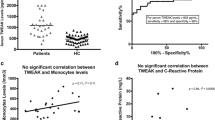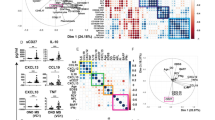Abstract
Expression and function of the immunoregulatory molecule HLA-E was investigated in patients with relapsing-remitting (RR) multiple sclerosis (MS). Serum and cerebrospinal fluid (CSF) soluble (s)HLA-E and -G levels were measured by ELISA in 80 RRMS patients. Controls were patients with other inflammatory neurological disorders (OIND, n = 81) and noninflammatory neurological disorders (NIND, n = 86). Serum sHLA-E concentrations were higher in RRMS than in NIND patients only. CSF sHLA-E concentrations were higher in RRMS than controls. Increased CSF sHLA-E levels were detected in MRI inactive and clinically stable RRMS patients. sHLA-E intrathecal synthesis (ITS) was higher in RRMS than controls, and the number of patients with sHLA-E ITS above cut-off was higher i) in MS than controls, and ii) in clinically stable than clinically active MS patients. sHLA-E CSF levels and ITS correlated with i) the same sHLA-G parameters, and ii) disease duration. HLA-E expression and co-expression with CD markers were investigated in MS plaques from three different cases by immunohistochemistry and confocal microscopy, respectively. Infiltrating T lymphocytes and macrophages, as well as resident microglial cells and astrocytes expressed HLA-E. CSF samples from MS patients were finally tested for inhibitory activity of in vitro CTL and NK cell mediated cytotoxicity. sHLA-E+ were more effective than sHLA-E− CSF samples in such inhibition. Maximum inhibition was achieved with sHLA-E+/sHLA–G+ CSF samples In conclusion, increased sHLA-E CSF levels may play an immunomodulatory role in MS, contributing to the inhibition of intrathecal inflammatory response. The potential of sHLA-E as biomarker of MS activity warrants further investigation.







Similar content being viewed by others
References
Allard M, Oger R, Vignard V, Percier JM, Fregni G, Perier A, Caignard A, Charreau B, Bernardeau K, Khammari A, Dreno B, Gervois N (2011) Serum soluble HLA-E in melanoma: a new potential immune-related marker in cancer. PLoS One 6:e21118
Braud VM, Allan DS, Wilson D, McMichael AJ (1998a) TAP- and tapasin-dependent HLA-E surface expression correlates with the binding of an MHC class I leader peptide. Curr Biol 8:1–10
Braud VM, Allan DS, O’Callaghan CA, Soderstrom K, D’Andrea A, Ogg GS, Lazetic S, Young NT, Bell JI, Phillips JH, Lanier LL, McMichael AJ (1998b) HLA-E binds to natural killer cell receptors CD94/NKG2A, B and C. Nature 391:795–799
Coupel S, Moreau A, Hamidou M, Horejsi V, Soulillou JP, Charreau B (2007) Expression and release of soluble HLA-E is an immunoregulatory feature of endothelial cell activation. Blood 109:2806–2814
Durrenberger PF, Webb LV, Sim MJ, Nicholas RS, Altmann DM, Boyton RJ (2012) Increased HLA-E expression in white matter lesions in multiple sclerosis. Immunology 137:317–325
Fainardi E, Rizzo R, Melchiorri L, Vaghi L, Castellazzi M, Marzola A, Govoni V, Paolino E, Tola MR, Granieri E, Baricordi OR (2003) Presence of detectable levels of soluble HLA-G molecules in CSF of relapsing-remitting multiple sclerosis: relationship with CSF soluble HLA-I and IL-10 concentrations and MRI findings. J Neuroimmunol 142:149–158
Fainardi E, Rizzo R, Melchiorri L, Castellazzi M, Paolino E, Tola MR, Granieri E, Baricordi OR (2006) Intrathecal synthesis of soluble HLA-G and HLA-I molecules are reciprocally associated to clinical and MRI activity in patients with multiple sclerosis. Mult Scler 12:2–12
Fainardi E, Rizzo R, Melchiorri L, Stignani M, Castellazzi M, Caniatti ML, Baldi E, Tola MR, Granieri E, Baricordi OR (2007) Soluble HLA-G molecules are released as HLA-G5 and not as soluble HLA-G1 isoforms in CSF of patients with relapsing-remitting multiple sclerosis. J Neuroimmunol 192:219–225
Fainardi E, Rizzo R, Melchiorri L, Stignani M, Castellazzi M, Tamborino C, Paolino E, Tola MR, Granieri E, Baricordi OR (2008) CSF levels of soluble HLA-G and Fas molecules are inversely associated to MRI evidence of disease activity in patients with relapsing-remitting multiple sclerosis. Mult Scler 14:446–454
Fainardi E, Castellazzi M, Stignani M, Morandi F, Sana G, Gonzalez R, Pistoia V, Baricordi OR, Sokal E, Pena J (2011) Emerging topics and new perspectives on HLA-G. Cell Mol Life Sci 68:433–451
Garcia P, Llano M, de Heredia AB, Willberg CB, Caparros E, Aparicio P, Braud VM, Lopez-Botet M (2002) Human T cell receptor-mediated recognition of HLA-E. Eur J Immunol 32:936–944
Goverman J (2009) Autoimmune T cell responses in the central nervous system. Nat Rev Immunol 9:393–407
Huang YH, Zozulya AL, Weidenfeller C, Metz I, Buck D, Toyka KV, Bruck W, Wiendl H (2009) Specific central nervous system recruitment of HLA-G(+) regulatory T cells in multiple sclerosis. Ann Neurol 66:171–183
Kren L, Slaby O, Muckova K, Lzicarova E, Sova M, Vybihal V, Svoboda T, Fadrus P, Lakomy R, Vanhara P, Krenova Z, Sterba J, Smrcka M, Michalek J (2011) Expression of immune-modulatory molecules HLA-G and HLA-E by tumor cells in glioblastomas: an unexpected prognostic significance? Neuropathology 31:129–134
Kurtzke JF (1983) Rating neurologic impairment in multiple sclerosis: an expanded disability status scale (EDSS). Neurology 33:1444–1452
Le Bouteiller P, Lenfant F (1996) Antigen-presenting function(s) of the non-classical HLA-E, -F and -G class I molecules: the beginning of a story. Res Immunol 147:301–313
Llano M, Lee N, Navarro F, Garcia P, Albar JP, Geraghty DE, Lopez-Botet M (1998) HLA-E-bound peptides influence recognition by inhibitory and triggering CD94/NKG2 receptors: preferential response to an HLA-G-derived nonamer. Eur J Immunol 28:2854–2863
Lu L, Kim HJ, Werneck MB, Cantor H (2008) Regulation of CD8+ regulatory T cells: interruption of the NKG2A-Qa-1 interaction allows robust suppressive activity and resolution of autoimmune disease. Proc Natl Acad Sci U S A 105:19420–19425
Lublin FD, Reingold SC (1996) Defining the clinical course of multiple sclerosis: results of an international survey. National Multiple Sclerosis Society (USA) Advisory Committee on Clinical Trials of New Agents in Multiple Sclerosis. Neurology 46:907–911
McDonald WI, Compston A, Edan G, Goodkin D, Hartung HP, Lublin FD, McFarland HF, Paty DW, Polman CH, Reingold SC, Sandberg-Wollheim M, Sibley W, Thompson A, van den Noort S, Weinshenker BY, Wolinsky JS (2001) Recommended diagnostic criteria for multiple sclerosis: guidelines from the International Panel on the diagnosis of multiple sclerosis. Ann Neurol 50:121–127
O’Callaghan CA, Bell JI (1998) Structure and function of the human MHC class Ib molecules HLA-E, HLA-F and HLA-G. Immunol Rev 163:129–138
Pietra G, Romagnani C, Mazzarino P, Falco M, Millo E, Moretta A, Moretta L, Mingari MC (2003) HLA-E-restricted recognition of cytomegalovirus-derived peptides by human CD8+ cytolytic T lymphocytes. Proc Natl Acad Sci U S A 100:10896–10901
Pistoia V, Morandi F, Wang X, Ferrone S (2007) Soluble HLA-G: are they clinically relevant? Semin Cancer Biol 17:469–479
Prigione I, Penco F, Martini A, Gattorno M, Pistoia V, Morandi F (2011) HLA-G and HLA-E in patients with juvenile idiopathic arthritis. Rheumatology (Oxford) 50:966–972
Rabot M, Tabiasco J, Polgar B, Aguerre-Girr M, Berrebi A, Bensussan A, Strbo N, Rukavina D, Le Bouteiller P (2005) HLA class I/NK cell receptor interaction in early human decidua basalis: possible functional consequences. Chem Immunol Allergy 89:72–83
van Velzen M, Laman JD, Kleinjan A, Poot A, Osterhaus AD, Verjans GM (2009) Neuron-interacting satellite glial cells in human trigeminal ganglia have an APC phenotype. J Immunol 183:2456–2461
Wiendl H, Feger U, Mittelbronn M, Jack C, Schreiner B, Stadelmann C, Antel J, Brueck W, Meyermann R, Bar-Or A, Kieseier BC, Weller M (2005) Expression of the immune-tolerogenic major histocompatibility molecule HLA-G in multiple sclerosis: implications for CNS immunity. Brain 128:2689–2704
Acknowledgments
We thank Mrs. Camilla Valentino for excellent secretarial assistance. This work have been supported by Ministero del Lavoro, della Salute e delle Politiche Sociali (Progetti di Ricerca Corrente) and by Research Program Regione Emilia Romagna - University 2007–2009, (Innovative Research) - code PRUa1a-2007–008. The authors declare that they have no conflict of interest.
Author information
Authors and Affiliations
Corresponding author
Rights and permissions
About this article
Cite this article
Morandi, F., Venturi, C., Rizzo, R. et al. Intrathecal Soluble HLA-E Correlates with Disease Activity in Patients with Multiple Sclerosis and may Cooperate with Soluble HLA-G in the Resolution of Neuroinflammation. J Neuroimmune Pharmacol 8, 944–955 (2013). https://doi.org/10.1007/s11481-013-9459-3
Received:
Accepted:
Published:
Issue Date:
DOI: https://doi.org/10.1007/s11481-013-9459-3




